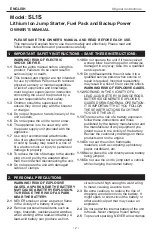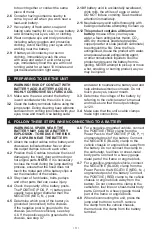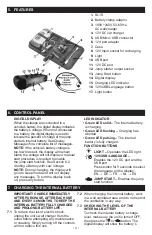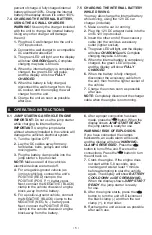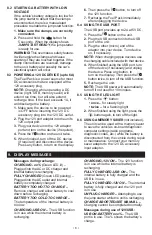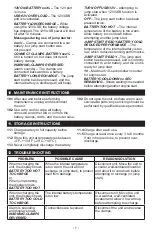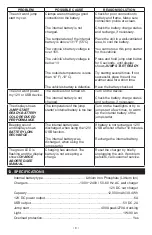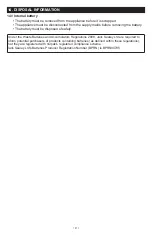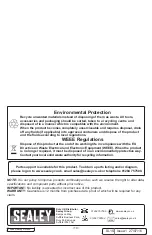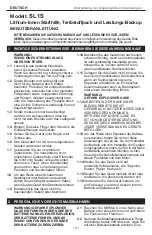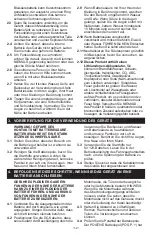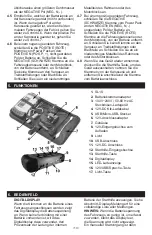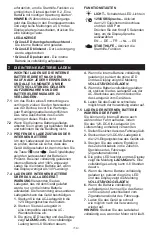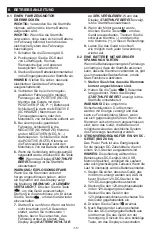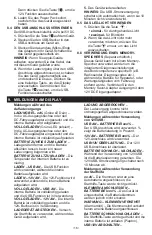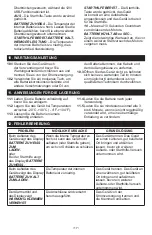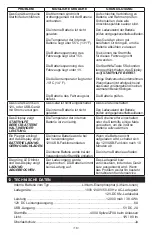
• 3 •
to touch together or contact the same
piece of metal.
2.6
Consider having someone nearby to
come to your aid when you work near a
lead-acid battery.
2.7
Have plenty of fresh water, soap and
baking soda nearby for use, in case battery
acid contacts your eyes, skin, or clothing.
2.8
Wear complete eye and body protection,
including safety goggles and protective
clothing. Avoid touching your eyes while
working near the battery.
2.9
If battery acid contacts your skin or
clothing, immediately wash the area
with soap and water. If acid enters your
eye, immediately flood the eye with cold
running water for at least 10 minutes and
get medical attention right away.
2.10
If battery acid is accidentally swallowed,
drink milk, the whites of eggs or water.
DO NOT induce vomiting. Seek medical
attention immediately.
2.11
Neutralize any acid spills thoroughly with
baking soda before attempting to clean up.
2.12 This product contains a lithium ion
battery.
In case of fire, you may use
water, a foam extinguisher, Halon, CO
2
,
ABC dry chemical, powdered graphite,
copper powder or soda (sodium carbonate)
to extinguish the fire. Once the fire is
extinguished, douse the product with water,
an aqueous-based extinguishing agent,
or other nonalcoholic liquids to cool the
product and prevent the battery from re-
igniting. NEVER attempt to pick up or move
a hot, smoking, or burning product, as you
may be injured.
3. PREPARING TO USE THE UNIT
WARNING! RISK OF CONTACT WITH
BATTERY ACID. BATTERY ACID IS A
HIGHLY CORROSIVE SULFURIC ACID.
3.1
Make sure the area around the battery
is well ventilated while the unit is in use.
3.2
Clean the battery terminals before using the
jump starter. During cleaning, keep airborne
corrosion from coming into contact with your
eyes, nose and mouth. Use baking soda
and water to neutralize the battery acid and
help eliminate airborne corrosion. Do not
touch your eyes, nose or mouth.
3.3
Determine the voltage of the battery by
referring to the vehicle owner’s manual
and make sure that the output voltage
is 12V.
3.4
Make sure that the unit’s cable clamps
make tight connections.
4. FOLLOW THESE STEPS WHEN CONNECTING TO A BATTERY
WARNING! A SPARK NEAR THE
BATTERY MAY CAUSE A BATTERY
EXPLOSION. TO REDUCE THE RISK
OF A SPARK NEAR THE BATTERY:
4.1
Attach the output cables to the battery and
chassis as indicated below. Never allow
the output clamps to touch each other.
4.2
Position the DC cables to reduce the risk of
damage by the hood, door and moving or
hot engine parts.
NOTE:
If it is necessary
to close the hood during the jump starting
process, ensure that the hood does not
touch the metal part of the battery clips or
cut the insulation of the cables.
4.3
Stay clear of fan blades, belts, pulleys
and other parts that can cause injury.
4.4
Check the polarity of the battery posts.
The POSITIVE (POS, P, +) battery post
usually has a larger diameter than the
NEGATIVE (NEG, N, -) post.
4.5
Determine which post of the battery is
grounded (connected) to the chassis.
If the negative post is grounded to the
chassis (as in most vehicles), see step
4.6. If the positive post is grounded to the
chassis, see step 4.7.
4.6
For a negative-grounded vehicle, connect
the POSITIVE (RED) clamp from the
Power Pack to the POSITIVE (POS, P, +)
ungrounded post of the battery. Connect
the NEGATIVE (BLACK) clamp to the
vehicle chassis or engine block away from
the battery. Do not connect the clamp to
the carburetor, fuel lines or sheet-metal
body parts. Connect to a heavy gauge
metal part of the frame or engine block.
4.7
For a positive-grounded vehicle, connect
the NEGATIVE (BLACK) clamp from the
Power Pack to the NEGATIVE (NEG, N, -)
ungrounded post of the battery. Connect
the POSITIVE (RED) clamp to the vehicle
chassis or engine block away from the
battery. Do not connect the clamp to the
carburetor, fuel lines or sheet-metal body
parts. Connect to a heavy gauge metal
part of the frame or engine block.
4.8
When disconnecting the unit, press the
jump start button to turn off, remove
the clamp from the vehicle chassis,
then remove the clamp from the battery
terminal.


